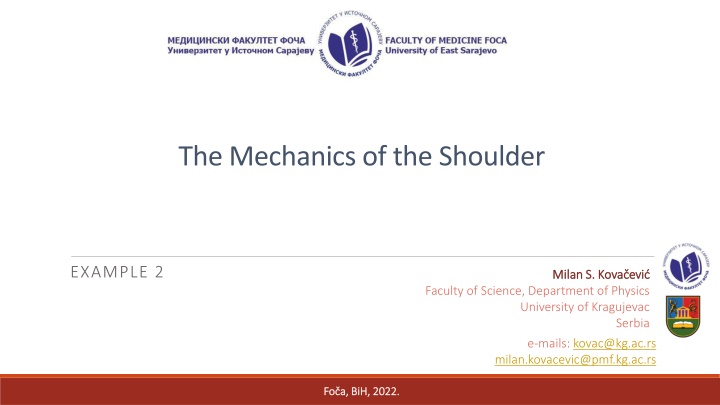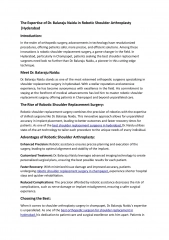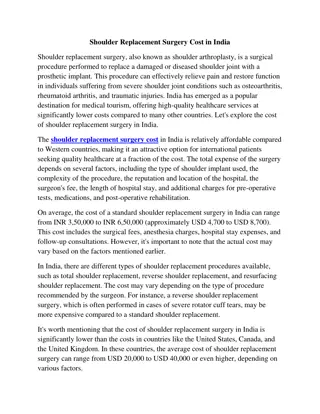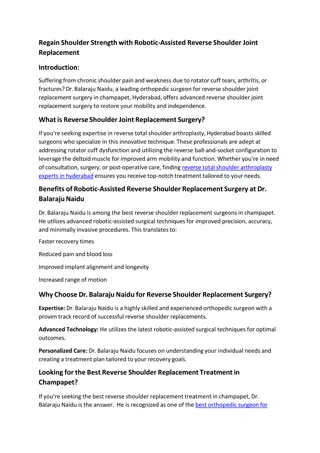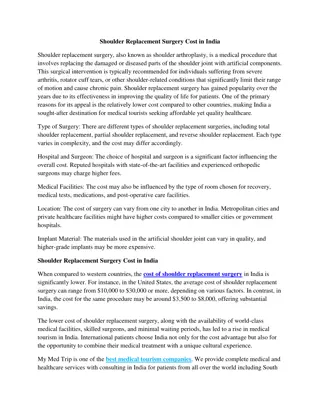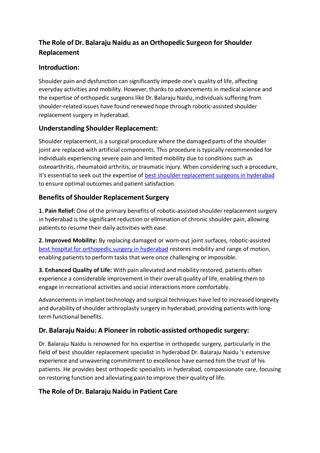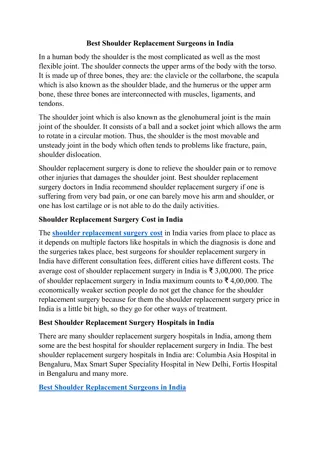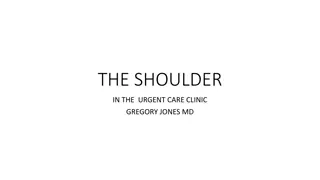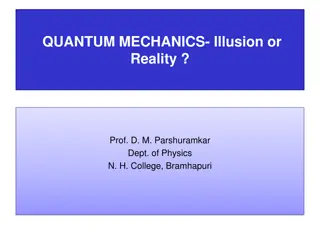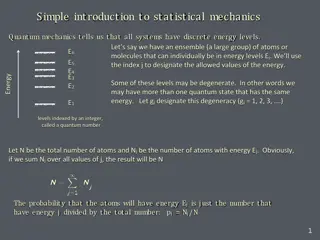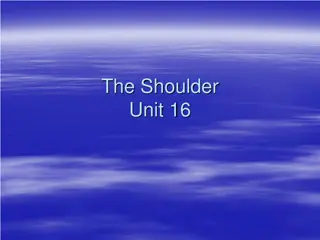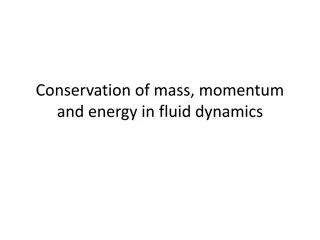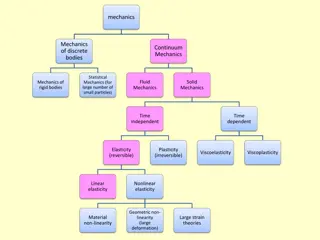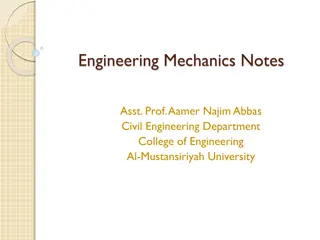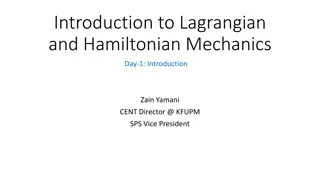The Mechanics of the Shoulder
The mechanics of the shoulder joint through a problem-solving approach involving muscle forces, joint reactions, and equilibrium equations. Learn how to determine the forces exerted during arm abduction exercises.
Download Presentation

Please find below an Image/Link to download the presentation.
The content on the website is provided AS IS for your information and personal use only. It may not be sold, licensed, or shared on other websites without obtaining consent from the author.If you encounter any issues during the download, it is possible that the publisher has removed the file from their server.
You are allowed to download the files provided on this website for personal or commercial use, subject to the condition that they are used lawfully. All files are the property of their respective owners.
The content on the website is provided AS IS for your information and personal use only. It may not be sold, licensed, or shared on other websites without obtaining consent from the author.
E N D
Presentation Transcript
The Mechanics of the Shoulder EXAMPLE 2 Milan S. Kova evi Milan S. Kova evi Faculty of Science, Department of Physics University of Kragujevac Serbia e-mails: kovac@kg.ac.rs milan.kovacevic@pmf.kg.ac.rs Fo a, BiH, Fo a, BiH, 202 2022. 2.
Forces acting on the arm and a mechanical model Consider a person strengthening the shoulder muscles by means of dumbbell exercises. Figure 5.11 illustrates the position of the left arm when the arm is fully abducted to horizontal. The free-body diagram of the arm is shown in Fig. 5.12 along with a mechanical model of the arm. Also in Fig. 5.12, the forces acting on the arm are resolved into their rectangular components along the horizontal and vertical directions. Fo a, BiH, Fo a, BiH, 202 2022. 2.
Mechanical model - description Point O corresponds to the axis of rotation of the shoulder joint, point A is where the deltoid muscle is attached to the humerus, point B is the center of gravity of the entire arm, and point C is the center of gravity of the dumbbell. W is the weight of the arm, Wo is the weight of the dumbbell, FM is the magnitude of the tension in the deltoid muscle, and Fj is the joint reaction force at the shoulder. The resultant of the deltoid muscle force makes an angle with the horizontal. The distances between point O and points A, B, and C are measured as a, b, and c, respectively Fo a, BiH, Fo a, BiH, 202 2022. 2.
The task Determine the magnitude FM of the force exerted by the deltoid muscle to hold the arm at the position shown. Also determine the magnitude and direction of the reaction force at the shoulder joint in terms of specified parameters. Fo a, BiH, Fo a, BiH, 202 2022. 2.
The solution With respect to the xy coordinate frame, the muscle and joint reaction forces have two components while the weights of the arm and the dumbbell act in the negative y direction. The components of the muscle force are Components of the joint reaction force are is the angle that the joint reaction force makes with the horizontal. The line of action and direction (in terms of y) of the force exerted by the muscle on the arm are known. However, the magnitude FM of the muscle force, the magnitude Fj, and the direction ( ) of the joint reaction force are unknowns. We have a total of three unknowns, FM, Fj, and (or FM, FJx, and FJy). To be able to solve this two dimensional problem, we have to utilize all three equilibrium equations. Fo a, BiH, Fo a, BiH, 202 2022. 2.
The Solution First, consider the rotational equilibrium of the arm about the shoulder joint at point O. The joint reaction force produces no torque about point O because its line of action passes through it. For practical purposes, we can neglect the possible contribution of the horizontal component of the muscle force to the moment generated about point O by assuming that its line of action also passes through point O. Note that this is not a critical or necessary assumption to solve this problem. If we knew the length of its moment arm (i.e., the vertical distance between O and A), we could easily incorporate the torque generated by FMx about point O into the analysis. Under these considerations, there are only three moment producing forces about point O. For the rotational equilibrium of the arm, the net moment about point O must be equal to zero. Fo a, BiH, Fo a, BiH, 202 2022. 2.
The Solution moments equations Taking counterclockwise moments to be positive Fo a, BiH, Fo a, BiH, 202 2022. 2.
The Solution Knowing the rectangular components of the joint reaction force enables us to compute the magnitude of the force itself and the angle its line of action makes with the horizontal: Fo a, BiH, Fo a, BiH, 202 2022. 2.
Remarks FMx is the stabilizing component and FMy is the rotational component of the deltoid muscle. FMx is approximately four times larger than FMy. A large stabilizing component suggests that the horizontal position of the arm is not stable, and that the muscle needs to exert a high horizontal force to stabilize it. The human shoulder is very susceptible to injuries. The most common injuries are dislocations of the shoulder joint and the fracture of the humerus. Since the socket of the glenohumeral joint is shallow, the head of the humerus is relatively free to rotate about the articulating surface of the glenoid fossa. This freedom of movement is achieved, however, by reduced joint stability. The humeral head may be displaced in various ways, depending on the strength or weakness of the muscular and ligamentous structure of the shoulder, and depending on the physical activity. Humeral fractures are another common type of injuries. The humerus is particularly vulnerable to injuries because of its unprotected configuration. Fo a, BiH, Fo a, BiH, 202 2022. 2.
Remarks Average ranges of motion of the arm about the shoulder joint are 2300 during flexion extension, and 1700 in both abduction adduction and inward outward rotation.
Thank you for your atention Thank you for your atention! ! Dr Milan Kova evi , Full Professor Faculty of Science, Department of Physics University of Kragujevac kovac@kg.ac.rs milan.kovacevic@pmf.kg.ac.rs Fo a, BiH, Fo a, BiH, 202 2022. 2.
